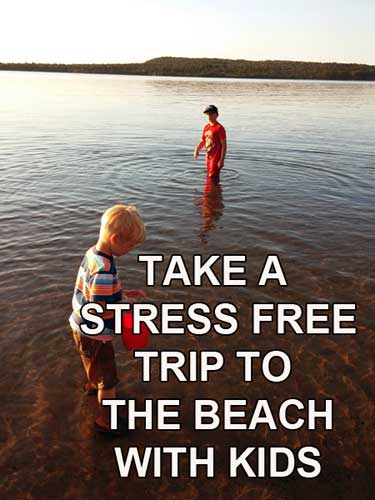Take a Stress Free Trip to the Beach with Kids
 We make the most out of our warm Michigan summers by hitting the beach as often as we can. Beautiful Gun Lake at Yankee Springs State Park is just a few minutes from our house. We swim there as many as three times a week once school it out. Lake Michigan is about an hour away, and we make several trips there every season as well.
We make the most out of our warm Michigan summers by hitting the beach as often as we can. Beautiful Gun Lake at Yankee Springs State Park is just a few minutes from our house. We swim there as many as three times a week once school it out. Lake Michigan is about an hour away, and we make several trips there every season as well.
There was a time I considered taking two kids to the beach a chore, but after ten years, I have it down to a science. Everyone is able to have fun and relax, even me. Here’s how I do it:
1. Prepare the evening before. I pack the night before we go. That way I’m not scrambling to find the sunscreen or clean beach towels just before we walk out the door.
2. It’s best to arrive at the beach early. That’s one reason why I like to be ready to go the night before. If you get there before the crowd arrives, you can stake out a good spot close to the water’s edge or score a picnic table in the shade. Also, kids aren’t tired in the morning, so they’re less likely to have a meltdown. We usually get to the beach about 10am. It’s warm enough by then, but the crowds aren’t there yet.
3. Have realistic expectations. You might imagine yourself lounging on the beach, reading a book. But once you have kids the beach is no longer a place where you get to kick back. Be prepared to remain alert, active and in the water. If there are lifeguards on duty, there’s only a couple to watch the hundreds of people in the water. Your best bet for keeping your kids safe is keeping your eyes on them. That doesn’t mean you can’t have fun. The beach is an opportunity to focus on your kids and play with them. At least you’re still working on your tan.
4. Put swimwear on before you leave. It’s so much easier to get dressed at home. Some beaches don’t have changing rooms, and the ones that do are often crowded and hot. If you need to stop somewhere before the beach, throw a cover-up or shorts and tee over everyone’s suit.
5. Use spray-on sunscreen. I’ve read some articles that say it’s difficult to get good coverage with spray-on sunscreen. I’ve never had a problem with it. If it’s breezy, do remember to spray in the same direction the wind is blowing. If you don’t, it could just blow away rather than land on your skin. I like spray-on sunscreen because it goes on quickly, isn’t greasy and is easier to get on a squirming child. Remember to apply 15 minutes before going out in the sun. Do this at home too, if you aren’t driving far.
6. Protect your valuables. What do you do with your keys, credit cards and money while you’re in the water? Find an opaque, re-usable water bottle with a wide-mouth, and stash your valuables in it. No one will ever suspect what’s in it if they see it poking out of your beach bag.
7. Use a wagon or tote with wide wheels to carry everything from the car to the beach. You’ll need something to haul all those towels, sand toys and snacks. Don’t try to push a stroller through the sand. Those small wheels just aren’t made for the beach.
8. I love Stearns Puddle Jumper Life Jackets (Coast Guard approved) for non-swimmers. They give kids more freedom to move around than standard life jackets, and they’re more secure than inflatable arm floaties. It does a great job of keeping kids’ heads above the water. Since kids can move better in the Puddle Jumper, it also makes it easier for them to learn to swim.
9. Take lots of sand toys to encourage breaks from the water. Getting them out of the water is the only way you’ll spend any time resting on your beach blanket. Time on the shore will also help them not get fatigued, which can lead to accidents.
10. Be aware of beach hazards and warnings. Many beaches and the national weather service post them online, so you can check before you leave. Stay out of the Great Lakes on days there are rip current warnings. Rip currents can quickly sweep you away from the shore even in a shallow area. Trying to swim against them can exhaust you before you reach land. If you are caught in one, try to swim out of it to the left or right rather than straight to shore. You’ll also want to stay out of the water if there’s a contamination warning.
11. Take plenty of bottled water and stay hydrated. It’s easy to get dehydrated at the beach, because you may not notice the symptoms of thirst when you’re in the water. The hot sun and vigorous activity in the water can dry you out just like it can on land.
12. Change out of swimwear at home. If home or the hotel is a short drive, have everyone drip-dry on the beach for a few minutes. Skip the changing room again, and head home. Bring some extra towels in the car for the ride home, and have everyone sit on one in case they’re still a little damp.



